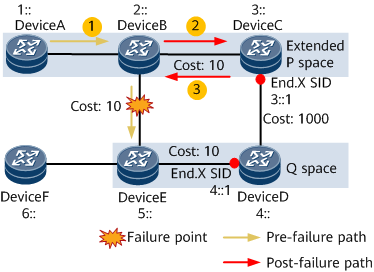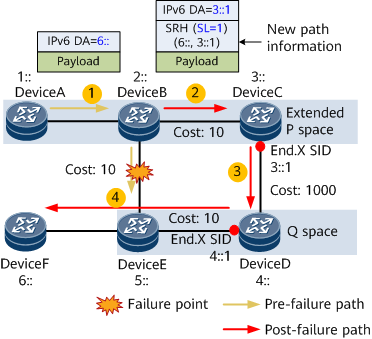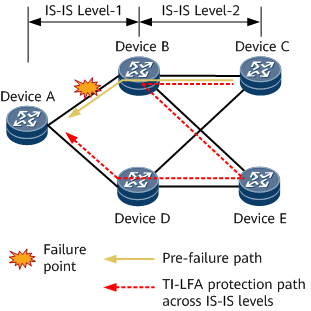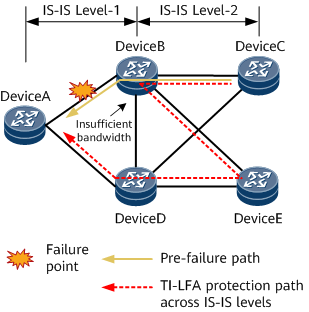SRv6 TI-LFA FRR
Conventional loop-free alternate (LFA) requires that at least one neighbor be a loop-free next hop to the destination, and remote LFA (RLFA) requires that at least one node be connected to the source and destination nodes without traversing the failure point. In contrast, Topology-Independent Loop-free Alternate (TI-LFA) FRR uses an explicit path to represent a backup path, achieving higher FRR reliability without imposing topology constraints.
SRv6 TI-LFA FRR applies to both SRv6 BE and SRv6 TE Policy scenarios. Although SRv6 BE packets typically do not carry SRH information, they do in TI-LFA FRR scenarios to encapsulate repair list information.
SRv6 TI-LFA
TI-LFA FRR provides link and node protection for SRv6. Figure 2 shows how SRv6 TI-LFA FRR is implemented.
TI-LFA Protection Across IS-IS Levels
By default, SRv6 TI-LFA computes backup paths only in the same IS-IS level. On the IS-IS network shown in Figure 3, DeviceA is a Level-1 device, DeviceC and DeviceE are Level-2 devices, and DeviceB and DeviceD are Level-1-2 devices between which no physical link exists.
If data traffic is sent from DeviceC to DeviceA and the link between DeviceA and DeviceB fails, SRv6 TI-LFA cannot provide protection because no backup path is available in IS-IS Level-1.
To address the preceding issue, SRv6 TI-LFA supports TI-LFA protection across IS-IS levels, enabling IS-IS to compute SRv6 TI-LFA backup paths across levels. On the network shown in Figure 3, DeviceB pre-computes an SRv6 TI-LFA backup path (DeviceB->DeviceE->DeviceD->DeviceA) that transits Level-2, so that traffic can be transmitted over the backup path to meet SLA requirements if the link between DeviceA and DeviceB fails.
In the Level-1 ring networking scenario shown in Figure 4, DeviceB and DeviceD are connected using a physical link, meaning that an SRv6 TI-LFA backup path can be provided for the primary link between DeviceA and DeviceB in Level-1. However, the bandwidth of the physical link between DeviceB and DeviceD may be insufficient to carry a large number of services. To address this issue, DeviceB can be configured to preferentially select a protection path that crosses IS-IS levels as the SRv6 TI-LFA backup path (DeviceB->DeviceE->DeviceD->DeviceA).
If data traffic reaches DeviceD along the SRv6 TI-LFA backup path, a loop may occur in some scenarios. For example:
- If the link between DeviceD and DeviceA also fails, DeviceD may send the traffic back to DeviceB, resulting in a loop.
- If the link between DeviceD and DeviceA is normal but its cost is high, DeviceD may consider DeviceB as the next hop and send traffic to it when the link between DeviceA and DeviceB recovers and DeviceD converges first. This also results in a loop.



